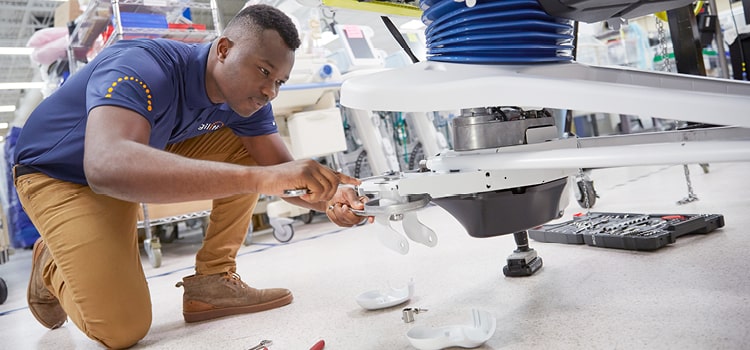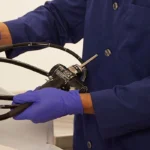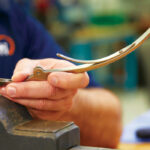Hospital beds are the backbone of patient care (pun intended). Yet, they’re commonly treated like non-technical components of the patient room. The truth is, modern hospital beds are not simple pieces of hardware — they’re filled with advanced technology and are increasingly complex and time consuming to maintain and repair.
In-house Healthcare Technology Management and facilities teams find themselves spending more time and energy keeping up with service on these increasingly complex devices, while also juggling expanding service demands for all other equipment inside the hospital.
Here are three contributing factors making it more challenging for healthcare facilities to service hospital beds.
- Oh Look How Far They’ve Come!
Today, specialty hospital beds are loaded with technology and enhanced capabilities to improve patient comfort and experience – from patient lift technology, to integrated bed exit systems, to USB ports for patients to charge their phones. These beds are also capable of fully integrating into an organization’s electronic medical record (EMR) — collecting and transmitting real-time data on patient conditions and behaviors, such as scale data and bed-exit status.
- They’re Taking Over!
With variable patient volumes over the past year, hospitals understand more than ever the importance of maintaining a tip-top bed fleet and not leaving anything to chance. Technology has advanced in the development of specialty beds and therapy surfaces for at-risk patient groups (such as bariatric, fall risk, early mobility or skin integrity) and those technology advancements are quickly finding their way into hospitals. Combined with data from the last 12 months of the COVID-19 pandemic, it’s not difficult to see how bed and therapy surfaces inventories have grown significantly over the last decade.
- Where’s the storage!
This growth has put a strain on existing storage capacity in most hospitals. The added challenge of allotting, managing and maintaining space within biomed or facilities departments is just not on top of the to-do list. In some cases, this can create a ‘cemetery’ of broken beds sitting in unused hallways awaiting repair or parts – beds that remain in clinical engineering backlog as devices deemed higher priority receive service first.
What Do These Factors Mean for Biomedical Teams?
Keeping these complex medical devices fully functional and in patient-ready condition is critical to both clinical outcomes and patient experiences, including keeping up with basic preventive maintenance (PM). For biomed teams, this presents some significant hurdles, including:
- Beds are often looked at as a simple component of hospital inventory when, in reality, they require a lot of time and attention. Asking your in-house HTM staff to shoulder this burden has its costs. Biomed and clinical engineering teams are already overwhelmed with larger inventories of medical equipment like vents and pumps. Adding additional work could risk impacting uptime of other high-value equipment, like imaging systems and ventilators.
- Advancements in technology require additional staff training that is sometimes out of scope for what is normally requested for most biomeds. For example, successfully harnessing and integrating bed data into an EMR is not a simple task, and general maintenance teams do not always have the IT/technical training and understanding to manage this integration. There’s also the ongoing challenge of getting the training/knowledge to service the technical components of a bed, including footboard and siderail electrical panels.
- Bed maintenance backlogs result in multiple challenges and tend to create the impression that there isn’t enough equipment available. This often results in increased rental and/or capital purchases, which diminishes the ROI of the initial bed purchases. Backlogs can also impact specialty bed availability for at-risk patient groups, which could delay care and increase the risk of hospital-acquired conditions (HACs).
- Value-added tasks and projects get put on the back burner as biomed teams are forced to spend more time on work perceived as lower value. Biomed teams are being asked to do more every single year. Yet, the time required to manage the service demands of movable medical equipment prevents them from contributing more to high-value, high-reward tasks like technology evaluations, capital planning and inventory management.
Questions to consider
As you evaluate your bed service management strategy, consider the following:
- How long does it take to manage all repairs and PM services for your hospital bed inventory?
- Are you fully staffed to meet the requirements of modern bed management and stay ahead of PMs/repair?
- How often do you experience bed service backlogs due to time-constraints or parts delays?
- Does your biomed team have the experience/training required to service specialty beds according to OEM specifications?
- Do you currently have any financial concerns when it comes to bed maintenance?
The bed maintenance problem doesn’t have a simple solution, but all hospitals should be taking a closer look at how beds are managed and maintained. Then, it’s a matter of examining how to close gaps, address risks and fully leverage the sophisticated technological capabilities of modern beds to deliver better patient care and achieve smarter, more efficient operations. These are challenges that not only require a technical and dedicated skillset, but experience building organization-wide workflows and strategies.
We’re helping hospitals solve the bed maintenance challenges every day – with on-demand, supplemental HTM support. Contact us today if you’d like some help.











